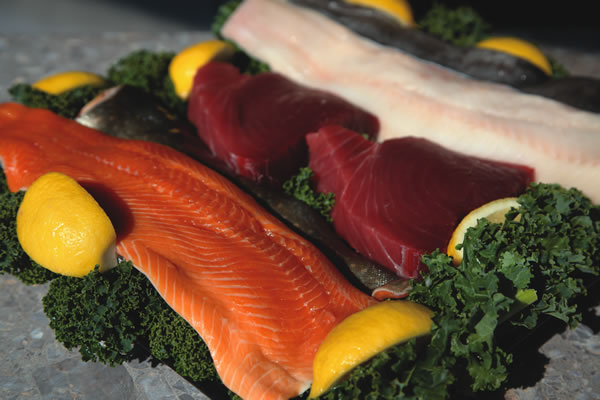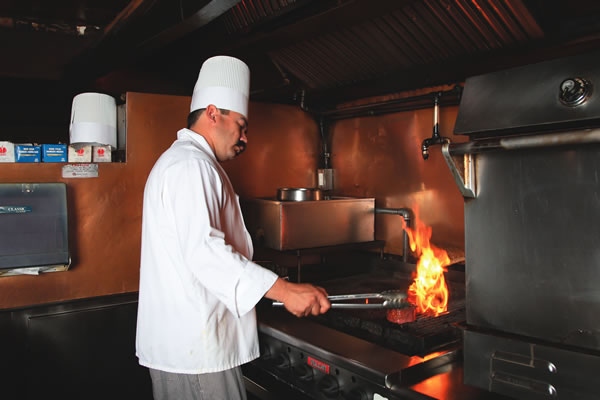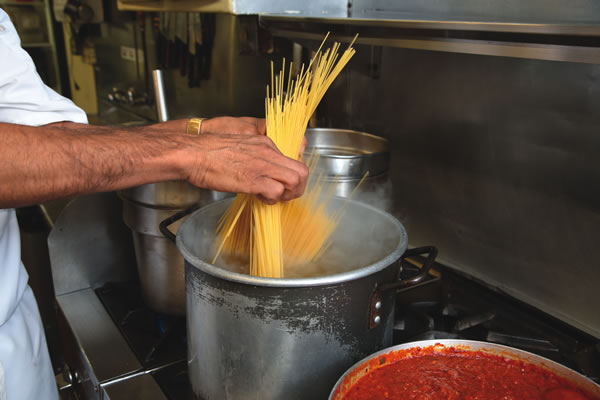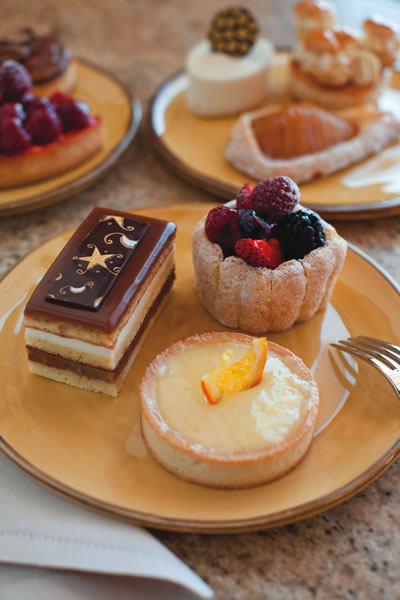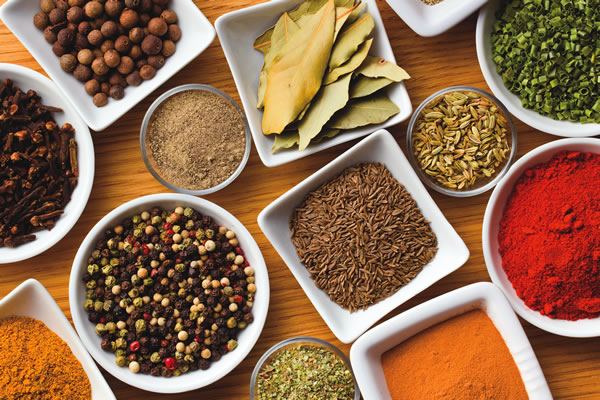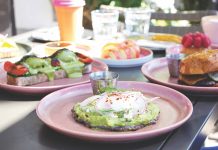“What would [insert name of celebrity chef] do?”
By Patrick Mott I PHOTOS BY Jody Tiongco
For many amateur home cooks, there comes a quick bolt of anxiety—often at the beginning of the cooking process, when they find a prime cut steak or a perfect filet of high-end fish, or the fresh ingredients for a cake or pie staring back at them, and the thought screams out: “What would [insert name of celebrity chef] do?”
It could be the simple consequences of too many hours spent watching the Food Network, but home kitchen amateurs dearly love to try to cook like the pros, and with good reason—the pros know all of the good tricks.
Fortunately, those experts are often willing to share their celebrity chef secrets. We found a handful of Newport’s top chefs who were happy to let us in on some of the best and most useful tips, tricks and techniques in their particular specialties that elevate dishes from merely good to truly memorable.
Fresh Catch
Let’s start with a category that too often gives at-home cooks that little adrenalin surge: seafood. The amateurs might think nothing of whipping up something featuring a chicken breast, but when it comes to fish and shellfish, the main ingredient often doesn’t come cheaply, and more than one seafood meal has been ruined because of simple lack of proper attention. So here’s the No. 1 rule from Bob Vogel, the director of retail and commissary operations for Costa Mesa-based Santa Monica Seafood: “The general rule of thumb is 10 minutes of cooking—whatever style of heat—per inch of thickness, pretty much for any fish. So if it’s a swordfish on the barbecue and it’s an inch thick, then four to five minutes on each side, and it’s medium rare. You want to keep things translucent in the center because fish that’s cooking will continue to cook once it’s away from the heat. That’s why it’s better to undercook something as opposed to overcooking because if that happens, you’re done—toast.”
Cooking with the overhead broiler? Place the fish about eight to 10 inches from the heat source. Baking? Set it to 350 to 375 degrees, depending on whether you want the fish to come out in 16 to 18 minutes, or 13 to 16 minutes. (This rule applies to all cuts of fish.)
Preparing shellfish presents an opportunity to get even more tactile. Such tidbits as clams and mussels often sit on ice in a display case, Bob says, which might cause them to gape a bit. “Take one of them [and] put it in your hand, and your body heat should warm it up and the shell should close back up.” That’s a keeper, he explains. “For good, fresh oysters that you can shuck or throw on the barbecue, you want to be able to click two of them together and they should sound like two pieces of rock—not one hollow, one solid. If you get that hollow sound with one, it could be alive, but it could be on its last legs. No point in taking the risk—discard it.”
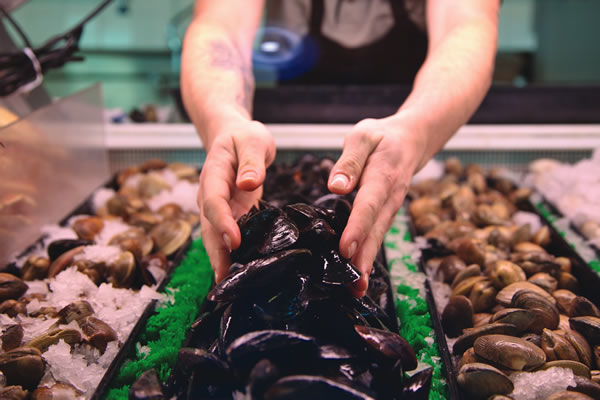
Man the Grill
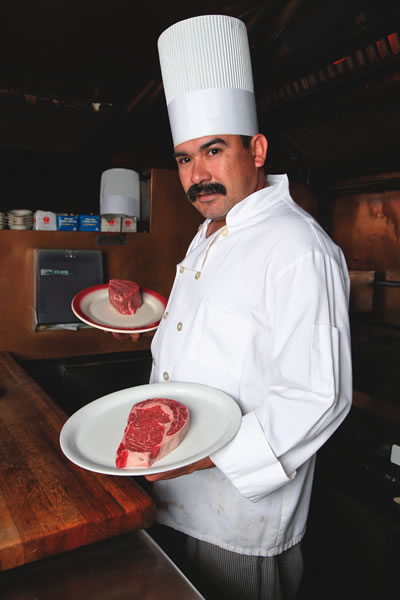 Few restaurants in Orange County are known for steaks like La Cave. They’ve been turning out memorable ones since 1962, and chef Luis Orozco is the latest steak specialist to man the little grill in the dim, cozy basement restaurant. To Luis, producing a magnificent steak is “really simple” yet requires the utmost care and attention.
Few restaurants in Orange County are known for steaks like La Cave. They’ve been turning out memorable ones since 1962, and chef Luis Orozco is the latest steak specialist to man the little grill in the dim, cozy basement restaurant. To Luis, producing a magnificent steak is “really simple” yet requires the utmost care and attention.
“First, get the best you can afford, generally from a good butcher or meat specialty store,” he says. Whatever the cut, it shouldn’t contain a lot of connective tissue or gristle.
He adds, “You don’t want to see your steak with no marbling—you don’t want to be eating a rubber band.”
You’ll never see a steak sitting in the middle of Luis’ grill—that’s the hottest spot. He positions the meat around the perimeter, where it can cook more slowly. “I don’t want to get charcoaling on the side from cooking too fast,” he says. “I don’t want to rush it.”
The key is to always keep an eye on the steak, he explains. “You never leave it alone. This is really, really important.” It may involve a bit of trial and error, but once you develop a routine of checking both sides of the cut several times during the cooking process, you’ll soon develop a practiced eye for the perfectly done steak. Cooking time, he says, will vary with the desired doneness and thickness of the steak, but there is no one-size-fits-all rule of thumb; eyeballing remains the big idea.
Many associate a delicious steak with a tasty marinade. Not so, Luis says. He uses only “a little soy sauce and a little pepper. Nothing else.”
Pasta and Pizza Prep
Hetty Robinson has been on close terms with all sorts of pasta since her parents bought Amelia’s Restaurant on Balboa Island in 1961. Now, as Amelia’s co-owner and supervising chef, she still uses her mother’s simple techniques for making sure this Italian staple comes out right every time.
“The No. 1 tip that Amelia always taught me—the first thing she would do—check the water the pasta was going to cook in,” Hetty says. “See if there was enough salt, because without that, you’re going to have bland pasta.” Hetty doesn’t use measuring spoons for such things, but you actually should be able to taste the salt in the water, she notes.
She continuously checks the consistency of the pasta, the true old-fashioned way: She takes a piece out of the water and bites into it. “You want it to be al dente (literally ‘to the tooth,’ meaning a slight resistance in the center). To me, that’s what cooking’s all about; you have to taste what you’re cooking.”
As for pastas like lasagna or ravioli, which aren’t as easy to fish out of the water and taste, Hetty pokes those with a fingernail or pierces them with a knife. It takes a bit of practice, she says, “but it’s just a feel.”
In the U.S., we’ve largely ceded pizza-making to the pros. It’s one of our favorite things to eat, but when it comes to doing it ourselves, we’ll pick up the phone before we’ll pick up the flour.
It doesn’t have to be that way. If you’re willing to roll up your sleeves and knead a bit of dough (a great stress reliever), chef and owner of Sapori Ristorante, Sal Maniaci, provides a handful of tips that will smooth the way to success.
First, you’ll need three items: a pizza stone, a pizza paddle and a pizza wheel cutter (inexpensive, and sometimes available as a three-item kit). A cookie sheet won’t do, Sal notes. “You definitely need the stone; it has to do with the way the heat radiates. A cookie sheet heats up so fast that it’ll burn the crust. It just won’t come out right,” he explains.
When kneading the dough, the ideal surface is wood or granite, somewhat warm. A cold surface, says Sal, will inhibit the yeast. Also, the water for the dough should be around 100 degrees.
Chef Sal prefers high-grade flour without much gluten content and a type of yeast called “cake yeast” that’s available at specialty stores. “It makes the crust lighter and gives it a better consistency,” he says.
Toppings are, of course, a personal choice, but Sal always makes sure to use a puree of top-quality Italian tomatoes and a little salt for a base. And, just as with chef Luis’ vigilance with steaks, the pizza cook needs always to observe the pizza as it bakes, occasionally lifting an edge with the paddle to check for doneness. When the borders of the pie are golden brown, it’s time to take it out and slice it up, Sal says.
Sweet Endings
Pastry chefs may work in kitchens, but they might as well be called laboratories. Quantities, temperatures, timing and other things you grappled with in chemistry class come into constant play. At The Resort at Pelican Hill, pastry chef Jeff Lehuede turns out everything from humble cookies to magnificent architectural creations, but abides by a handful of time-proven techniques.
“Pastries require great accuracy,” he says. “I like to have all my recipes in grams or ounces, if possible. You can find inexpensive scales that can do both.”
And, he adds, never neglect your main piece of equipment—the oven. Make sure it’s calibrated properly so that 350 degrees truly is 350 degrees.
Common main ingredients—butter, sugar, eggs, chocolate—all benefit from being taken out of the refrigerator well before they’re needed (butter the night before, eggs two hours before). “Everything is more creamy that way and it mixes better,” Jeff explains. “If the butter, for instance, is not mixed well you may not see it, but when it bakes it’s going to cook and boil on its own and your pastry is going to look very greasy, and because it’s losing the butter it’s going to be more dry.”
Presentation is vital in pastry making, Jeff adds, and there are easy ways to make your creation shine. “The vessel that it’s in should be interesting,” he says. “And a dash of powdered sugar is very easy, or if you have something like apple pie you can use a dash of cinnamon powder. Also a sprig of mint or a few fresh berries cut in half. If you have gelato, you can crumble cookie pieces over it to make it more interesting.
“You always enjoy pastries with your eyes first,” Jeff says.
A Taste of India
Cooking Indian food can be great fun and yield spectacular results, but just looking at a classic recipe can set many novice chefs back on their heels.
“Most are daunted by the sheer length of the list of ingredients,” says Alfred Prasad, executive chef at Tamarind of London in Newport Beach. “When they want to start cooking even the most basic of Indian recipes, they imagine this huge list of ingredients they must shop for, and they don’t know how much of what to buy.”
But there’s nothing wrong with keeping things simple for beginners, says Alfred, who also presides over the kitchen of the original Tamarind in London.
Ground spices like cumin and turmeric, whole cinnamon and cardamom, and ginger and garlic paste are a few must-haves, most of which the chef recommends only buying in very small quantities, as Indian recipes typically don’t call for very much.
An alternative to whole spices is garam masala, an already made mix of essential spices like coriander and rose petals. “It’s a kind of finishing powder on top of a dish, a finishing spice for a curry,” Alfred says. The mix also assures the novice chef that a piece of whole spice won’t find its way into the final dish.
“One of the worst things that can happen is that you bite into a clove of green cardamom,” he says.
Two final tips from Alfred to keep the chef in good shape: Put onions in the refrigerator for an hour or so before chopping them to eliminate the tears. And coat your fingers with cooking oil before handling or chopping hot red or green peppers. When you wash your hands later, the potentially burning capsaicin will come off with the oil. NBM


